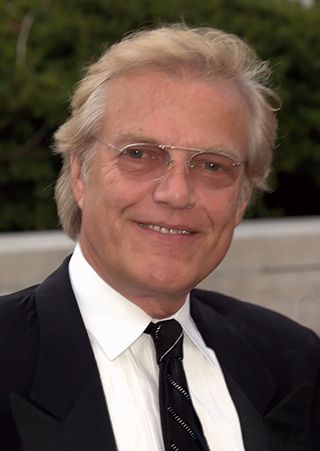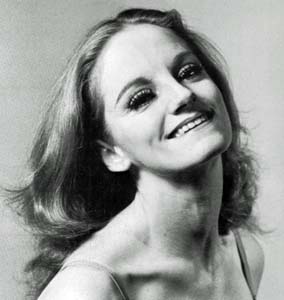Related Research Articles

New York City Ballet (NYCB) is a ballet company founded in 1948 by choreographer George Balanchine and Lincoln Kirstein. Balanchine and Jerome Robbins are considered the founding choreographers of the company. Léon Barzin was the company's first music director. City Ballet grew out of earlier troupes: the Producing Company of the School of American Ballet, 1934; the American Ballet, 1935, and Ballet Caravan, 1936, which merged into American Ballet Caravan, 1941; and directly from the Ballet Society, 1946.

Les Sylphides is a short, non-narrative ballet blanc to piano music by Frédéric Chopin, selected and orchestrated by Alexander Glazunov.

Suzanne Farrell is an American ballerina and the founder of the Suzanne Farrell Ballet at the Kennedy Center in Washington, D.C.

Darci Kistler is an American ballerina. She is often said to be the last muse for choreographer George Balanchine.

Peter Martins is a Danish former ballet dancer and choreographer. Martins was a principal dancer with the Royal Danish Ballet and with the New York City Ballet, where he joined George Balanchine, Jerome Robbins, and John Taras as balletmaster in 1981. He retired from dancing in 1983, having achieved the rank of danseur noble, becoming Co-Ballet Master-In-Chief with Robbins. From 1990 until January 2018, he was responsible for artistic leadership of City Ballet.
Peter Boal is artistic director of Pacific Northwest Ballet and director of its affiliated school in Seattle, Washington. He was born in Bedford, New York, in 1965 and began studies at the School of American Ballet (SAB) at age nine.
Symphony in C, originally titled Le Palais de Cristal, is a ballet choreographed by George Balanchine, to Georges Bizet's Symphony in C. The ballet was originally created for the Paris Opera Ballet, and premiered on July 28, 1947 at Théâtre National de l'Opéra.
Kyra Nichols is an American retired ballet dancer and teacher. She joined the New York City Ballet in 1974 and was promoted to principal dancer in 1979. She is one of the last dancers to have worked with George Balanchine, although he did not create any new work on her. However, she originated roles in several ballets by Jerome Robbins. Nichols retired from performing in 2007, after a 33-year career.
Andantino, originally titled Pas de Deux, is a ballet choreographed by Jerome Robbins to the second movement of Tchaikovsky's Piano Concerto No. 1. The ballet was made for the New York City Ballet's Tchaikovsky Festival, and premiered on June 4, 1981, at the New York State Theater, originated by Darci Kistler and Ib Andersen.
Barbara Anne Milberg Fisher was an American academic and professional dancer. She was professor emerita of English at the City College of the City University of New York (CUNY), where she taught for 29 years. She published several works, including on the life of Wallace Stevens. Prior to her academic career, under her maiden name, Barbara Milberg, she danced with the short-lived Ballet Society, founded by George Balanchine and Lincoln Kirstein; became soloist with the New York City Ballet (NYCB) in its first decade; and then joined Jerome Robbins's newly formed Ballets: USA, touring Europe and the States with that company as a principal dancer.

Prodigal Son, or Le Fils prodigue, Op. 46 is a ballet created for Diaghilev's Ballets Russes by George Balanchine to music by Sergei Prokofiev (1928–29). The libretto, based on the parable in the Gospel of Luke, was by Boris Kochno, who added a good deal of drama and emphasized the theme of sin and redemption ending with the Prodigal Son's return.
Fanfare is a one-act ballet choreographed by Jerome Robbins to Benjamin Britten's The Young Person's Guide to the Orchestra, in celebration of the Coronation of Queen Elizabeth II. The ballet premiered on June 2, 1953, the night of the coronation, at the City Center of Music and Drama, danced by the New York City Ballet.
Mozartiana is a ballet choreographed by George Balanchine to Tchaikovsky's Orchestral Suite No. 4, Mozartiana. The current version of the ballet was made for New York City Ballet's Tchaikovsky Festival, and premiered on June 4, 1981, at the New York State Theater. It is considered Balanchine's last major work.

Kay Mazzo is an American former ballet dancer and educator. In 1961, she joined Jerome Robbins' company, Ballets USA. The following year, she joined the New York City Ballet and was promoted to principal dancer in 1969. She created roles for George Balanchine and Robbins, before retiring from performing in 1981. She then joined the permanent faculty of the School of American Ballet in 1983, named co-chairman of faculty in 1997 and chair of faculty in 2018. She stepped down from the position in June 2022, but continues to teach.
Robert Schumann’s “Davidsbündlertänze” is one of the last major works made by New York City Ballet's founding choreographer and balletmaster-in-chief, George Balanchine. It is set to Robert Schumann's Davidsbündlertänze, Op. 6 (1837). The idea for setting this piano work very likely came from a work created by Robert Joffrey for his own Joffrey Ballet Company, the premier of which took place at the City Center Theater in the late 1970s. Joffrey, in turn, received his inspiration from Jonathan Watts, a protege of Joffrey's and director of the Joffrey apprentice company, who, at the suggestion of pianist Neil Stannard, created a ballet titled Evening Dialogues to this same score. This initial version of the Schumann cycle was featured on tour with the Joffrey second company in the mid 1970a.

Chase Finlay is a former ballet dancer and former principal dancer with the New York City Ballet who has also danced with the Mariinsky Theatre in Russia.

Sally Harrington, known professionally as Sara Leland, was an American ballet dancer and répétiteur. She started her career with the Joffrey Ballet in 1959, and was recruited to join the New York City Ballet by George Balanchine in 1960. She was promoted to principal dancer in 1972, and created roles for both Balanchine and Jerome Robbins.
Stephanie Saland is an American former ballet dancer and teacher. She was spotted by George Balanchine whilst a student at the School of American Ballet, then joined the New York City Ballet in 1972, and was promoted to principal dancer in 1984. She had created roles for both Balanchine and Jerome Robbins, before retiring in 1993. She then started teaching ballet in both the U.S. and internationally.
Maria Calegari is an American ballet dancer, teacher and répétiteur. She joined the New York City Ballet in 1974 and became a principal dancer in 1983. She left the company in 1994, then occasionally performed until 2004. She also teaches ballet and began working as a répétiteur for the Balanchine Trust and Robbins Rights Trust in 1996 and 2003 respectively.
References
- ↑ Katy Matheson, "Andersen, Ib," in International Dictionary of Ballet, edited by Martha Bremser (Detroit: St. James Press, 1993), vol. 1, pp. 26–28.
- ↑ Erik Ashengreen, The Royal Danish Ballet and Bournonville (Copenhagen, 1979), pp. 16–17.
- ↑ Matheson, "Anderson, Ib" (1993), p. 26.
- ↑ Gia Kourlas, "Desert Sun No Shortage of Inspiration," interview with Ib Andersen, New York Times (17 February 2012).
- ↑ Choreography by George Balanchine: A Catalogue of Works (New York: Viking Penguin, 1993).
- ↑ Robert Maiorano, Balanchine's Mozartiana: The Making of a Masterpiece (New York: Freundlich Books, 1985).
- ↑ Kisselgoff, Anna (1 July 1990). "Review/City Ballet: Ib Andersen in a Fitting Farewell as Apollo". New York Times.
- ↑ Tobi Tobias, "Top of the New York City Ballet's Royal Danish Line: Ib Andersen," Dance Magazine (New York) (January 1985), pp. 46–49.
- ↑ Alexandra Tomalonis, "Ballet Today and Tomorrow: A Conversation with Ib Andersen," Dance View (Washington, D.C.), vol. 14, no. 1 (1996–1997), pp. 3–9.
- ↑ Alastair Macaulay, "Balanchine's Protégé Transplants the Spirit to the Southwest," New York Times (13 June 2010).
- ↑ Ballet Arizona: Ib Andersen biography